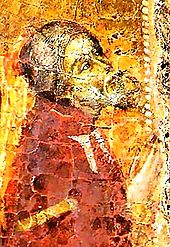
Don Quixote is a Spanish epic novel by Miguel de Cervantes. It was originally published in two parts, in 1605 and 1615. Considered a founding work of Western literature, it is often labelled as the first modern novel and one of the greatest works ever written. Don Quixote is also one of the most-translated books in the world and one of the best-selling novels of all time.
The Abbadid dynasty or Abbadids was an Arab dynasty from the tribe of Banu Lakhm of al-Hirah, which ruled the Taifa of Seville in al-Andalus following the downfall of the Caliphate of Cordoba in 1031. After the collapse, they were the most powerful Taifa and before long absorbed most of the others. Abbadid rule lasted from about 1023 until 1091, but during the short period of its existence it exhibited singular energy and typified its time.
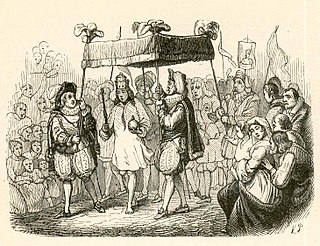
"The Emperor's New Clothes" is a literary folktale written by Danish author Hans Christian Andersen, about a vain emperor who gets exposed before his subjects. The tale has been translated into over 100 languages.

Medieval literature is a broad subject, encompassing essentially all written works available in Europe and beyond during the Middle Ages. The literature of this time was composed of religious writings as well as secular works. Just as in modern literature, it is a complex and rich field of study, from the utterly sacred to the exuberantly profane, touching all points in-between. Works of literature are often grouped by place of origin, language, and genre.

Juan Goytisolo Gay was a Spanish poet, essayist, and novelist. He lived in Marrakesh from 1997 until his death in 2017. He was considered Spain's greatest living writer at the beginning of the 21st century, yet he had lived abroad since the 1950s. On 24 November 2014 he was awarded the Cervantes Prize, the most prestigious literary award in the Spanish-speaking world.

Don Juan Manuel was a Spanish medieval writer, nephew of Alfonso X of Castile, son of Manuel of Castile and Beatrice of Savoy. He inherited from his father the great Lordship of Villena, receiving the titles of Lord, Duke and lastly Prince of Villena. He married three times, choosing his wives for political and economic convenience, and worked to match his children with partners associated with royalty. Juan Manuel became one of the richest and most powerful men of his time, coining his own currency as the kings did. During his life, he was criticised for choosing literature as his vocation, an activity thought inferior for a nobleman of such prestige.

An exemplum is a moral anecdote, brief or extended, real or fictitious, used to illustrate a point. The word is also used to express an action performed by another and used as an example or model.
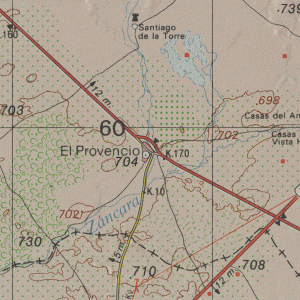
El Provencio is a small town and municipality in Cuenca, Spain with a population of 2,367permanent inhabitants. It offers a vibrant nightlife, attracting visitors from nearby towns like Las Pedroñeras for 'Las Fiestas'. It has kept much of its medieval heritage and is on the newly planted trail that marks the route followed by the title character Miguel de Cervantes's novel Don Quixote. El Provencio sits in the extreme southern area of Cuenca, bordering both Albacete and Ciudad Real. The major highway linking the town to the rest of Spain is the National 301 Madrid - Cartagena, and it is about 81 kilometers south of Cuenca, the city.

The Book of Fantasy is the English translation of Antología de la literatura fantástica, an anthology of approximately 81 fantastic short stories, fragments, excerpts, and poems edited by Jorge Luis Borges, Adolfo Bioy Casares, and Silvina Ocampo. It was first published in Argentina in 1940, and revised in 1965 and 1976. Anthony Kerrigan had previously translated a similar work by the same editors, Cuentos breves y extraordinarios (1955) as Extraordinary Tales, published by Herder & Herder in 1971. The 1988 Viking Penguin edition for English-speaking countries includes a foreword by Ursula K. Le Guin.
Emilio García Gómez, 1st Count of Alixares was a Spanish Arabist, literary historian and critic, whose talent as a poet enriched his many translations from Arabic.

Requiem for a Spanish Peasant is a famous short novel in twentieth-century Spanish literature by Spanish writer Ramón J. Sender. It conveys the thoughts and memories of Mosén Millán, a Catholic parish priest, as he sits in the vestry of a church in a nameless Aragonese village, preparing to conduct a requiem mass to celebrate the life of a young peasant named Paco killed by the Nationalist army a year earlier, at the outbreak of the Spanish Civil War. As he waits, his thoughts are interrupted by the occasional comings and goings of an altar boy, who hums to himself an anonymous ballad.
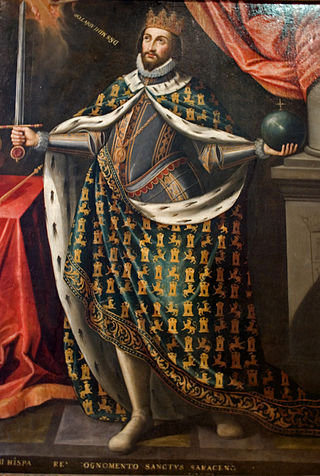
The sword Lobera was the symbol of power used by Saint Ferdinand III of Castile, instead of the more traditional rod, and so the king will be depicted with orb and sword in hand.

Bianca Minola is a character in Shakespeare's The Taming of the Shrew (c.1590–1594).
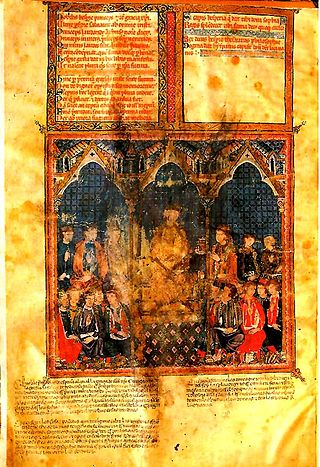
The Estoria de España, also known in the 1906 edition of Ramón Menéndez Pidal as the Primera Crónica General, is a history book written on the initiative of Alfonso X of Castile "El Sabio", who was actively involved in the editing. It is believed to be the first extended history of Spain in Old Spanish, a West Iberian Romance language that forms part of the lineage from Vulgar Latin to modern Spanish. Many prior works were consulted in constructing this history.
The Phantom Lady is a play by Spanish playwright Pedro Calderón de la Barca. It was written and performed in 1629 and was published for the first time in the Primera parte de comedias de don Pedro Calderón de la Barca (1636).

The miller, his son and the donkey is a widely dispersed fable, number 721 in the Perry Index and number 1215 in the Aarne–Thompson classification systems of folklore narratives. Though it may have ancient analogues, the earliest extant version is in the work of the 13th-century Arab writer Ibn Said. There are many eastern versions of the tale and in Europe it was included in a number of Mediaeval collections. Since then it has been frequently included in collections of Aesop's fables as well as the influential Fables of Jean de la Fontaine.
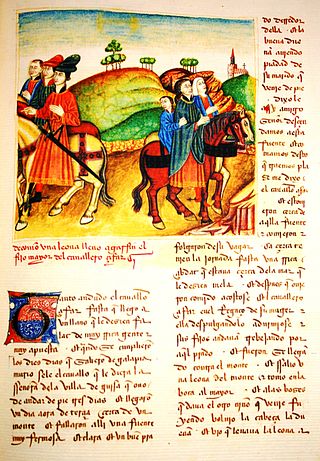
Medieval Spanish literature consists of the corpus of literary works written in Old Spanish between the beginning of the 13th and the end of the 15th century. Traditionally, the first and last works of this period are taken to be respectively the Cantar de mio Cid, an epic poem whose manuscript dates from 1207, and La Celestina (1499), a work commonly described as transitional between the Middle Ages and the Renaissance.
E'etemad al-Rumaikiyya was an Andalusian poet, consort of Emir Al-Mu'tamid of Seville. She is believed to have been born between 1045 and 1047.

Leon Walerian Ostroróg, was an Islamic scholar, jurist, adviser to the Ottoman government and émigré in Istanbul. He was also a writer and translator.

Amanda Junquera Butler was a Spanish writer. Raised in Madrid, she attended university during the Spanish Civil War at the University of Valencia. Junquera was a noted translator, chronicler, and short story writer in the mid-20th century, whose works and impact received new interest in the 21st century with republishing of some of her works and scholarship on her life.

